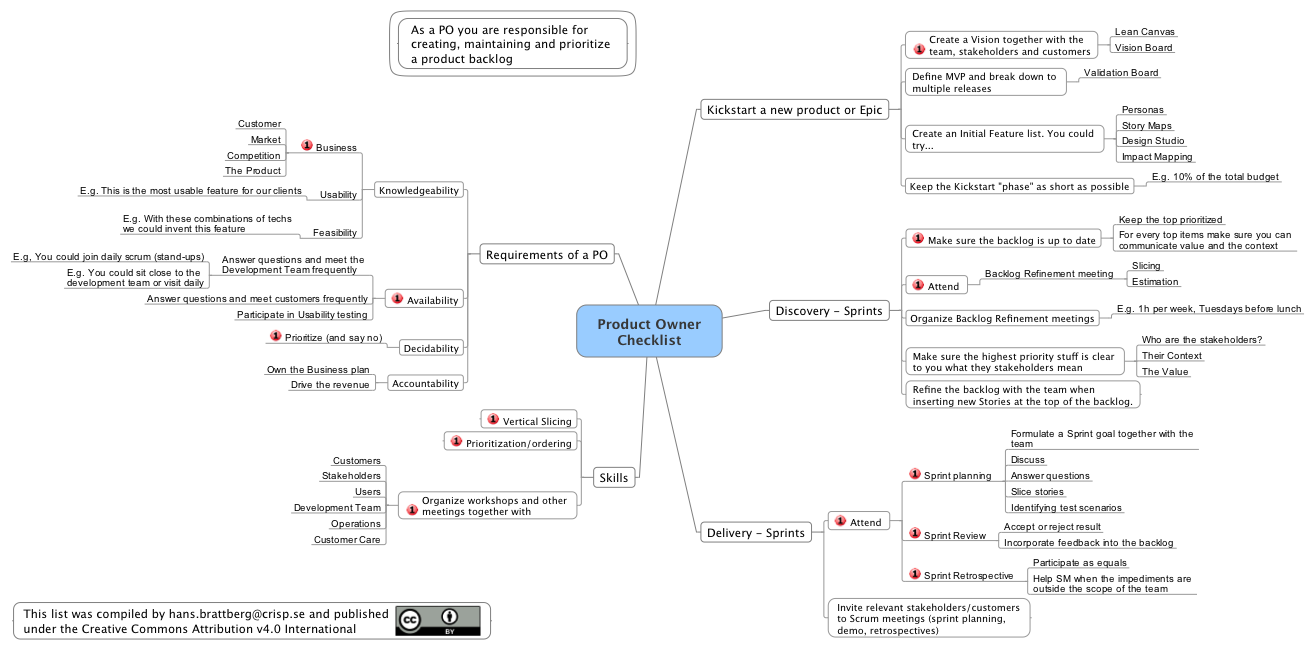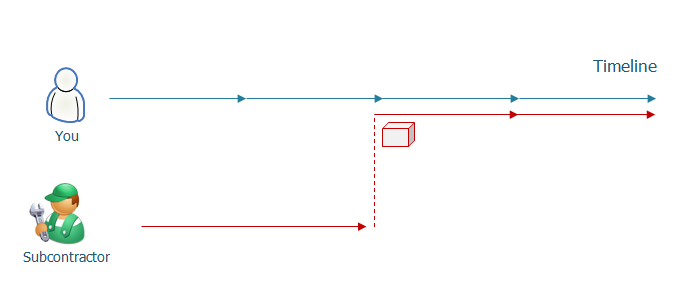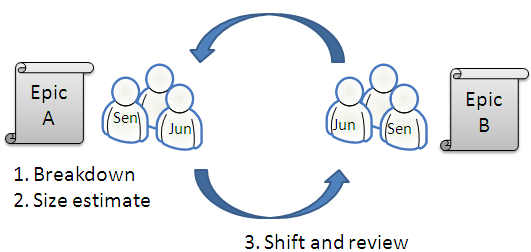If you wonder what a Scrum Product Owner need to do, here’s the checklist (in form of a mind map) for you!
Facilitating the Elephant Carpaccio Exercise
One of the best exercises I know of on how to learn and practice User Story slicing techniques is the so called Elephant Carpaccio exercise. At Spotify it is something of a staple as it it is (often) used when introducing new employees (now a days). Facilitating the Elephant carpaccio exercise from Peter Antman The
Continue readingLet the User Story Flow
One of my biggest surprises when I first met the squads I where going to work with at Spotify was that none of them were using User Stories. At first I observed to see their alternative. Unfortunately there was none. Instead most of the work got done as big chunks of work (what I would tend to call Epics) that was sliced into a todo-list of tasks (named that way by the developers) and also divided according different platforms.
Squad focus on technical tasks
A typical board contained one or more business cases and lanes for each developer/platform with tasks that were executed upon. These big “busses” where on the board blocking other works for weeks, which of course meant there needed to exist one or more emergency lanes for all expedite work (in the long run, most work).
This is a setup that does not foster collaboration, focus on value and art-of-the-possible. From an agile fluence point of view I would say it is a way of working that does not even reach fluence level 1 (Christian and I will describe agile fluence in more depth in a follow up blog post). From my experience focusing on User Stories is a great way of fostering the above values, and reach fluence level 1.
Time vs Story Points Estimation
One of the most common questions we get is whether to estimate in time or points. It seems like points are used only “to avoid thinking about time” and they are essentially the same. Wrong.
Let us give you the travel metaphor to give you an idea about how we are thinking.
Crisp for breakfast?
What’s this? An alien invasion? A publicity stunt? A way of sneaking Crisp into your cereals? You make the call. We Go Lean at breakfast, lunch and dinner! 🙂 This picture was forwarded by Troy Magennis, a Monte Carlo pioneer. PS: Troy is coming to Stockholm to show us how to use Monte Carlo to
Continue readingAddressing critical in deliveries from subcontractors
In software, one of our favorite tool to deal with uncertainty is iterations. But is it always the better option?
The last week I’ve got the question two times of how to address critical in deliveries from subcontractors. For example: hardware, preparation of land, machinery, buildings or third party platform updates. How can these be addressed? Do iterations hold the answer? Are there better options?
Let me introduce lean flow thinking and show how it can be used to improve the outcome of critical third party in deliveries in your projects.
Doing 45 minute sprint planning
I currently coach a system administration team. Anyone who has worked in one k
Doing kanban, we do iteration plannings every week and they need to be fast and accurate and we only need to keep a 45 min window. We have experimented with different approaches, and this has been the best working.
Continue readingMulti-team sprint planning
Here are the slides from my session "Multi-team sprint planning" from Scrum Gathering 2008 in Stockholm. Here is all the other material from the Scrum Gathering. Interesting stuff!
Continue readingPlanning ahead in Scrum
In Scrum it is often perceived that planning takes place on sprint planning day. Getting the required parties in the same place and do planning is a good way of making real time decisions. But getting people together is a dounting or impossible task and this also neglects some of the thought processes that needs to take place before stories are estimatable.
Continue readingHow to catch up on test automation
Many companies with existing legacy code bases bump into a huge impediment when they want to get agile: lack of test automation.
This article illustrates how to address this problem by creating a test automation backlog and implementing a few tests each sprint.
| Test case | Risk |
Manual test cost (man-hours) |
Automation cost (story points) |
| Block account | high | 5 hrs | 0.5 sp |
| Validate transfer | high | 3 hrs | 5 sp |
| See transaction history | medium | 3 hrs | 1 sp |
| Sort query results | medium | 2 hrs | 8 sp |
| Deposit cash | high | 1.5 hr | 1 sp |
| Security alert | high | 1 hr | 13 sp |
| Add new user | low | 0.5 hr | 3 sp |
| Change skin | low | 0.5 hr | 20 sp |
Index card generator – version 2!
Many people use a spreadsheet to house their Scrum Product Backlog. That works quite fine. However, during sprint planning meetings it is usually much more effective to use physical index cards. See my book Scrum and XP from the Trenches for the reasoning behind this. Here’s a simple tool that generates printable index cards in
Continue readingPlanning Poker
I’ve written up a page with a pretty graphical summary of what Planning Poker is. http://www.crisp.se/planningpoker/
Continue readingPrediction Markets och Scrum Sprint Planning
Jag har vagt känt till begreppet Prediction Markets, där man sammanfattar många individers förutspåelser om aktiekurser, vilken teknik som kommer att lyckas och misslyckas, och andra svåra frågor där enskilda individers kunskap ofta inte är tllräcklig, eller något man generellt sett inte litar på. Vem litar på enskilda aktieanalytiker, till exempel. Stötte nyligen på en
Continue reading










